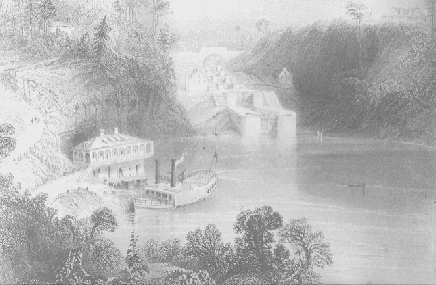| |
Rideau Canal
Where the tall timbers grew: Lumbering in the Ottawa Valley, 1840-present
Following the War of 1812, the British were concerned about the threat of invasion from the south by the new American nation. For this reason, they commissioned Lt. Col John By to construct a canal in defence of Canada.
Originally, the canal was simply to serve as a defensive mechanism for the transportation of men on a waterway far away from the St. Lawrence River and supplies in Canada. The canal was to link Ottawa and Kingston.
With considerable foresight, Col. By petitioned his office in London to build a wider canal than initially planned, in order that the new, wider steam vessels would also be accommodated, and hopefully foster settlement and economic development. |

|
Why the Canal was Built
Soon after John By left Québec, at the end of 1810, the irritations which had been developing between the United States of America and Great Britain so incensed President Madison that he persuaded the U.S. Congress to declare war upon Great Britain. If there had been a trans-Atlantic cable then in existence, the war would not have started since the British Parliament had removed the major irritants two days before Congress took action. News had to travel across the Atlantic by sailing ship. War was therefore declared on 18 June 1812. This war, known as the War of 1812, proved to be an indecisive conflict but did involve serious fighting between the U.S. and British forces. Naval fighting took place on Lake Ontario and along the Atlantic seaboard. Regular British troops, assisted by Canadian volunteers fought in both Upper and Lower Canada, fighting in which the fortress of Kingston, with its naval dockyard, was vital to the success of British arms.
The war was officially terminated by the Treaty of Ghent, signed on Christmas Eve 1814, but fighting continued for another two weeks, the last battle being fought near New Orleans, again because of the slowness of communications across the Atlantic. Despite the peace treaty, tempers remained hot on both sides of the Canada-United States border; records of the time show that there was a general feeling that hostilities would break out again. In view of this, the British military leaders at Kingston strongly urged that an alternative route between Montréal and Kingston must be found. Everything required for the maintenance and safety of Kingston had to be brought up the St.Lawrence in small bateaux or canoes, with difficult navigation through rapids up to Prescott and then smooth sailing until Lake Ontario was reached- but in international waters. One brigade of boats was ambushed there from the U.S. shore. This could be explained because there were no access roads to the American shore but it was found that the United States planned to rectify this before fighting broke out again.
An alternative route did exist, parts of which had been used by Indians for thousands of years. It involved coming up the Ottawa River, instead of the St.Lawrence, from Lake St.Louis. The rapids at Ste. Anne de Bellevue would have to be circumvented by a small lock. Just below Hawkesbury of today, there was a stretch of rough water extending to Pointe Fortune, twelve miles downstream; this would also have to be bypassed. Then came a smooth sail of about sixty miles up to the great barrier of the Chaudière. Just below these falls. The Rideau could be traversed, however, with portages at its many rapids and into the Rideau Lakes. A portage led from Rideau Lake into smaller lakes from which the Cataraqui River flowed down to Kingston, with many rapids on the way.
Nothing was done until the Duke of Richmond arrived at Québec in August 1818 to hold office as Governor in Chief. Within three months he had sent to the British Government a brilliant review of the measures necessary for the defence of British North America. He also arranged for a detailed survey of the twelve miles of rough water near Hawkesbury to be made, so that the best way of circumventing the rough water could be developed. The survey was made by an officer of the Royal Staff Corps, a company of which was then engaged on repair an maintenance work on the little locks in the Soulanges section of the St. Lawrence. To the orders of the Duke of Richmond, this company moved up to the Ottawa in the early summer of 1819 to make a start at the building of what would come to be known as the 'Ottawa River Canals'.
|
View the Photo Album
 |
|
